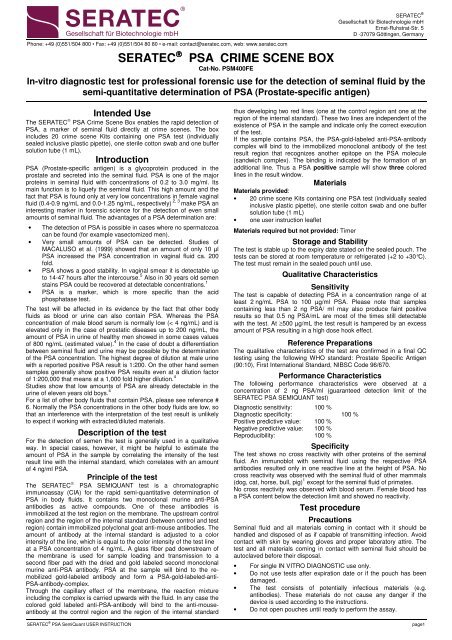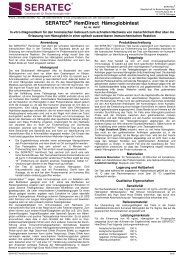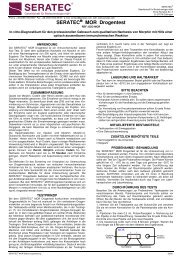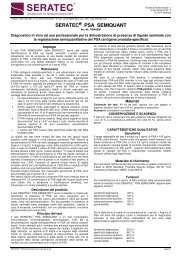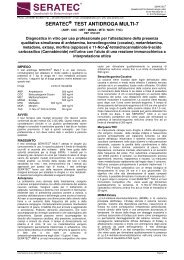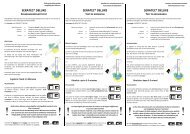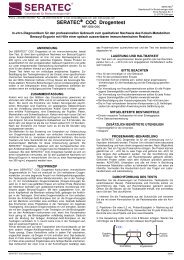SERATEC® PSA CRIME SCENE BOX
SERATEC® PSA CRIME SCENE BOX
SERATEC® PSA CRIME SCENE BOX
Create successful ePaper yourself
Turn your PDF publications into a flip-book with our unique Google optimized e-Paper software.
Phone: +49 (0)551/504 800 • Fax: +49 (0)551/504 80 80 • e-mail: contact@seratec.com, web: www.seratec.com<br />
SERATEC ® <strong>PSA</strong> <strong>CRIME</strong> <strong>SCENE</strong> <strong>BOX</strong><br />
Cat-No. PSM400FE<br />
SERATEC ®<br />
Gesellschaft für Biotechnologie mbH<br />
Ernst-Ruhstrat-Str. 5<br />
D -37079 Göttingen, Germany<br />
In-vitro diagnostic test for professional forensic use for the detection of seminal fluid by the<br />
semi-quantitative determination of <strong>PSA</strong> (Prostate-specific antigen)<br />
Intended Use<br />
The SERATEC ® <strong>PSA</strong> Crime Scene Box enables the rapid detection of<br />
<strong>PSA</strong>, a marker of seminal fluid directly at crime scenes. The box<br />
includes 20 crime scene Kits containing one <strong>PSA</strong> test (individually<br />
sealed inclusive plastic pipette), one sterile cotton swab and one buffer<br />
solution tube (1 mL).<br />
Introduction<br />
<strong>PSA</strong> (Prostate-specific antigen) is a glycoprotein produced in the<br />
prostate and secreted into the seminal fluid. <strong>PSA</strong> is one of the major<br />
proteins in seminal fluid with concentrations of 0.2 to 3.0 mg/ml. Its<br />
main function is to liquefy the seminal fluid. This high amount and the<br />
fact that <strong>PSA</strong> is found only at very low concentrations in female vaginal<br />
fluid (0.4-0.9 ng/mL and 0.0-1.25 ng/mL, respectively) 2, 3 make <strong>PSA</strong> an<br />
interesting marker in forensic science for the detection of even small<br />
amounts of seminal fluid. The advantages of a <strong>PSA</strong> determination are:<br />
• The detection of <strong>PSA</strong> is possible in cases where no spermatozoa<br />
can be found (for example vasectomized men).<br />
• Very small amounts of <strong>PSA</strong> can be detected. Studies of<br />
MACALUSO et al. (1999) showed that an amount of only 10 µl<br />
<strong>PSA</strong> increased the <strong>PSA</strong> concentration in vaginal fluid ca. 200<br />
fold.<br />
• <strong>PSA</strong> shows a good stability. In vaginal smear it is detectable up<br />
to 14-47 hours after the intercourse. 5 Also in 30 years old semen<br />
stains <strong>PSA</strong> could be recovered at detectable concentrations. 1<br />
• <strong>PSA</strong> is a marker, which is more specific than the acid<br />
phosphatase test.<br />
The test will be affected in its evidence by the fact that other body<br />
fluids as blood or urine can also contain <strong>PSA</strong>. Whereas the <strong>PSA</strong><br />
concentration of male blood serum is normally low (< 4 ng/mL) and is<br />
elevated only in the case of prostatic diseases up to 200 ng/mL, the<br />
amount of <strong>PSA</strong> in urine of healthy men showed in some cases values<br />
of 800 ng/mL (estimated value). 4 In the case of doubt a differentiation<br />
between seminal fluid and urine may be possible by the determination<br />
of the <strong>PSA</strong> concentration. The highest degree of dilution at male urine<br />
with a reported positive <strong>PSA</strong> result is 1:200. On the other hand semen<br />
samples generally show positive <strong>PSA</strong> results even at a dilution factor<br />
of 1:200,000 that means at a 1,000 fold higher dilution. 4<br />
Studies show that low amounts of <strong>PSA</strong> are already detectable in the<br />
urine of eleven years old boys. 4<br />
For a list of other body fluids that contain <strong>PSA</strong>, please see reference #<br />
6. Normally the <strong>PSA</strong> concentrations in the other body fluids are low, so<br />
that an interference with the interpretation of the test result is unlikely<br />
to expect if working with extracted/diluted materials.<br />
Description of the test<br />
For the detection of semen the test is generally used in a qualitative<br />
way. In special cases, however, it might be helpful to estimate the<br />
amount of <strong>PSA</strong> in the sample by correlating the intensity of the test<br />
result line with the internal standard, which correlates with an amount<br />
of 4 ng/ml <strong>PSA</strong>.<br />
Principle of the test<br />
The SERATEC ® <strong>PSA</strong> SEMIQUANT test is a chromatographic<br />
immunoassay (CIA) for the rapid semi-quantitative determination of<br />
<strong>PSA</strong> in body fluids. It contains two monoclonal murine anti-<strong>PSA</strong><br />
antibodies as active compounds. One of these antibodies is<br />
immobilized at the test region on the membrane. The upstream control<br />
region and the region of the internal standard (between control and test<br />
region) contain immobilized polyclonal goat anti-mouse antibodies. The<br />
amount of antibody at the internal standard is adjusted to a color<br />
intensity of the line, which is equal to the color intensity of the test line<br />
at a <strong>PSA</strong> concentration of 4 ng/mL. A glass fiber pad downstream of<br />
the membrane is used for sample loading and transmission to a<br />
second fiber pad with the dried and gold labeled second monoclonal<br />
murine anti-<strong>PSA</strong> antibody. <strong>PSA</strong> at the sample will bind to the remobilized<br />
gold-labeled antibody and form a <strong>PSA</strong>-gold-labeled-anti-<br />
<strong>PSA</strong>-antibody-complex.<br />
Through the capillary effect of the membrane, the reaction mixture<br />
including the complex is carried upwards with the fluid. In any case the<br />
colored gold labeled anti-<strong>PSA</strong>-antibody will bind to the anti-mouseantibody<br />
at the control region and the region of the internal standard<br />
thus developing two red lines (one at the control region ant one at the<br />
region of the internal standard). These two lines are independent of the<br />
existence of <strong>PSA</strong> in the sample and indicate only the correct execution<br />
of the test.<br />
If the sample contains <strong>PSA</strong>, the <strong>PSA</strong>-gold-labeled anti-<strong>PSA</strong>-antibody<br />
complex will bind to the immobilized monoclonal antibody of the test<br />
result region that recognizes another epitope on the <strong>PSA</strong> molecule<br />
(sandwich complex). The binding is indicated by the formation of an<br />
additional line. Thus a <strong>PSA</strong> positive sample will show three colored<br />
lines in the result window.<br />
Materials<br />
Materials provided:<br />
• 20 crime scene Kits containing one <strong>PSA</strong> test (individually sealed<br />
inclusive plastic pipette), one sterile cotton swab and one buffer<br />
solution tube (1 mL)<br />
• one user instruction leaflet<br />
Materials required but not provided: Timer<br />
Storage and Stability<br />
The test is stable up to the expiry date stated on the sealed pouch. The<br />
tests can be stored at room temperature or refrigerated (+2 to +30°C).<br />
The test must remain in the sealed pouch until use.<br />
Qualitative Characteristics<br />
Sensitivity<br />
The test is capable of detecting <strong>PSA</strong> in a concentration range of at<br />
least 2 ng/mL <strong>PSA</strong> to 100 µg/ml <strong>PSA</strong>. Please note that samples<br />
containing less than 2 ng <strong>PSA</strong>/ ml may also produce faint positive<br />
results so that 0.5 ng <strong>PSA</strong>/mL are most of the times still detectable<br />
with the test. At ≥500 µg/mL the test result is hampered by an excess<br />
amount of <strong>PSA</strong> resulting in a high dose hook effect.<br />
Reference Preparations<br />
The qualitative characteristics of the test are confirmed in a final QC<br />
testing using the following WHO standard: Prostate Specific Antigen<br />
(90:10), First International Standard, NIBSC Code 96/670.<br />
Performance Characteristics<br />
The following performance characteristics were observed at a<br />
concentration of 2 ng <strong>PSA</strong>/ml (guaranteed detection limit of the<br />
SERATEC <strong>PSA</strong> SEMIQUANT test)<br />
Diagnostic sensitivity: 100 %<br />
Diagnostic specificity: 100 %<br />
Positive predictive value: 100 %<br />
Negative predictive value: 100 %<br />
Reproducibility: 100 %<br />
Specificity<br />
The test shows no cross reactivity with other proteins of the seminal<br />
fluid. An immunoblot with seminal fluid using the respective <strong>PSA</strong><br />
antibodies resulted only in one reactive line at the height of <strong>PSA</strong>. No<br />
cross reactivity was observed with the seminal fluid of other mammals<br />
(dog, cat, horse, bull, pig) 1 except for the seminal fluid of primates.<br />
No cross reactivity was observed with blood serum. Female blood has<br />
a <strong>PSA</strong> content below the detection limit and showed no reactivity.<br />
Test procedure<br />
Precautions<br />
Seminal fluid and all materials coming in contact with it should be<br />
handled and disposed of as if capable of transmitting infection. Avoid<br />
contact with skin by wearing gloves and proper laboratory attire. The<br />
test and all materials coming in contact with seminal fluid should be<br />
autoclaved before their disposal.<br />
• For single IN VITRO DIAGNOSTIC use only.<br />
• Do not use tests after expiration date or if the pouch has been<br />
damaged.<br />
• The test consists of potentially infectious materials (e.g.<br />
antibodies). These materials do not cause any danger if the<br />
device is used according to the instructions.<br />
• Do not open pouches until ready to perform the assay.<br />
SERATEC ® <strong>PSA</strong> SemiQuant USER INSTRUCTION page1
Phone: +49 (0)551/504 800 • Fax: +49 (0)551/504 80 80 • e-mail: contact@seratec.com, web: www.seratec.com<br />
Specimen collection and handling<br />
In General: Seminal fluid should be diluted at least 1:500 prior to use<br />
because of its extremely high <strong>PSA</strong> content For the dilution we strongly<br />
recommend to use the provided buffer solution or alternatively a 1 M<br />
TRIS solution with a neutral pH value of 8.2.<br />
At the crime scene: Collected semen stains or swabs should be put in<br />
the provided buffer tube. Please break the wooden swab so that it fits<br />
into the buffer tube for extraction. After shaking for about two minutes,<br />
the solution can be used for the test. If the result is negative, the<br />
sample should be extracted for a longer time with the remaining buffer<br />
to avoid false negative results in case of a low <strong>PSA</strong> concentration of<br />
the sample.<br />
In the laboratory: Semen stains or swabs should be extracted with ca.<br />
250µL buffer about 2 hours by using a shaker. The extractive could be<br />
used directly or optionally centrifuged for about one minute at 13,000g.<br />
Then 200µL of the <strong>PSA</strong> containing supernatant is removed and used<br />
for the test. If the supernatant is too viscous because of a high <strong>PSA</strong><br />
concentration, it should be diluted. Particles of tissue do not interfere<br />
with the test result.<br />
Note!<br />
• A high viscosity of the sample might interfere with the capillary<br />
flow.<br />
• Allow samples to warm up to room temperature before starting the<br />
test.<br />
• A pH-value below 2 of the specimen can cause false positive or<br />
invalid results.<br />
Start of the assay<br />
• Bring test device to room temperature. Remove from protective<br />
pouch and label device for identification purposes.<br />
• Add five drops (about 200 µl) in the sample well. Keep remaining<br />
sample in case it might be necessary to test additional dilutions.<br />
• Read result after 10 minutes incubation at room temperature.<br />
There should be no remaining fluid in the sample well at this time<br />
point. If you want to estimate the amount of <strong>PSA</strong> by comparison<br />
with the internal standard keep strictly to the 10 minutes.<br />
Otherwise the intensities of the internal standard and the result<br />
may change resulting in incorrect readings.<br />
Interpretation of results<br />
<strong>PSA</strong> negative (below detection limit) samples will show 2 lines in the<br />
result well, whereas <strong>PSA</strong> positive samples will show 3 lines:<br />
Test result line (T): reflects <strong>PSA</strong> concentration of the<br />
sample, visible in <strong>PSA</strong>-positive samples only<br />
Internal Standard: color intensity correlates with a concentration of<br />
approximately 4 ng/mL <strong>PSA</strong><br />
Control Line (C): control for possible procedural errors and for the<br />
integrity of test components<br />
Negative result (no <strong>PSA</strong> in the probe or <strong>PSA</strong> concentration below<br />
detection limit)<br />
Test result line (T) is not detectable.<br />
Appearance of internal standard line<br />
and control line (C) confirm validity of<br />
the test. In this case the sample most<br />
likely does not contain seminal fluid.<br />
SERATEC ®<br />
Gesellschaft für Biotechnologie mbH<br />
Ernst-Ruhstrat-Str. 5<br />
D -37079 Göttingen, Germany<br />
Note:<br />
Make sure that the dilution of the probe leads to a <strong>PSA</strong> concentration<br />
within the detection range. <strong>PSA</strong> concentrations that are too low (e.g.<br />
due to insufficient extraction) or that are too high (e.g. due to<br />
insufficient dilution; 500 µg/mL result in a high dose hook effect)<br />
interfere with the formation of the test result.<br />
Positive result (<strong>PSA</strong> detectable)<br />
Test result line (T), internal standard<br />
line, and control line (C) appear.<br />
In this case it is very likely that the sample<br />
contains seminal fluid.<br />
Note:<br />
If there is the risk of mixing up <strong>PSA</strong> containing body fluids and seminal fluid<br />
you might try to get a more accurate result by testing higher dilutions.<br />
Invalid result<br />
Internal standard line and/or control line (C) are not detectable. The<br />
test is invalid and the assay should be repeated with a new test<br />
cassette.<br />
Note:<br />
If the sample contains high amounts of <strong>PSA</strong> it is possible that the color<br />
intensity the control line is only weak.<br />
Suggested reading/References<br />
1 Hochmeister et al. (1999) Evaluation of Prostate- Specific Antigen (<strong>PSA</strong>)<br />
Membrane Test Assays for the Forensic Identification of Seminal Fluid: J Forensic<br />
Sci Vol 44: 1057-1060<br />
2 Lawson et al. (1998) Objective markers of condom failure. Sex Transm Dis 25:<br />
SERATEC ® <strong>PSA</strong> SemiQuant USER INSTRUCTION page2<br />
427-423<br />
3 Macaluso et al. (1999) Prostate-specific antigen in vaginal fluid as a biologic<br />
marker of condome failure. Contraception 59: 195-201<br />
4 Sato et al. (2002) Use of the „SMITEST” <strong>PSA</strong> card to identify the presence of<br />
prostate –specific antigen in semen and male urine. Forensic Sci Int 127: 71-74<br />
5 Hochmeister et al. (1997) Evaluation of Prostrate-Specific Antigen (<strong>PSA</strong>)<br />
Membrane Tests for the Forensic Identification of Semen. 8 th International<br />
Symposium on Human Identification at<br />
www.promega.com/geneticidproc/ussymp8proc/33.html<br />
6 Laux et al., Forensic Detection of Semen III. Detection of <strong>PSA</strong> Using Membrane<br />
Based Tests: Sensitivity Issues with Regards to the presence of <strong>PSA</strong> in other Body<br />
Fluids. http://mafs.net/pdf/forensicdetectionsemen3.pdf<br />
7 Laux et al., Forensic Detection of Semen II. Comparison of the Abacus<br />
Diagnostics OneStep ABA card p30 Test and the SERATEC <strong>PSA</strong> Semiquant Kit<br />
for the Determination of the Presence of Semen in Forensic Cases.<br />
http://mafs.net/pdf/laux2.pdf<br />
8 Gartside et al., Estimation of Prostate-Specific Antigen (<strong>PSA</strong>) Extraction<br />
Efficiency from Forensic Samples Using the SERATEC <strong>PSA</strong> Semiquant<br />
Semiquantitative Membrane Test. Forensic Science Communications 2003 April; 5<br />
(2). http://www.fbi.gov/hq/lab/fsc/backissu/april2003/gartside.htm<br />
9 SERATEC GmbH: Summary about <strong>PSA</strong> in body fluids:<br />
http://www.seratec.com/docs/user_instructions/psa_in_body_fluids<br />
Symbols<br />
+2°C<br />
+30°C<br />
Expiry date<br />
Storage temperature<br />
Lot number<br />
Rev: March 2011


